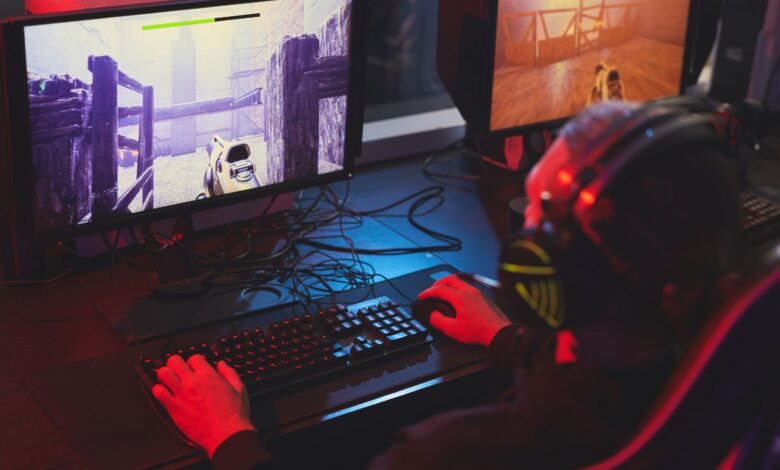Gameverse TheGameArchives: Unlocking the Past and Future of Gaming

Introduction
Gameverse TheGameArchives In today’s rapidly evolving digital landscape, gaming has expanded far beyond consoles and cartridges. Two unique yet powerful forces—Gameverse TheGameArchives—are shaping the way we interact with both the future and the past of gaming. Gameverse represents the cutting edge of interactive entertainment, a realm driven by blockchain, virtual reality, and NFTs. Meanwhile, TheGameArchives offers a nostalgic trip into the retro world, preserving thousands of classic titles once thought lost to time.
The convergence of these two platforms tells an intriguing story. While one strives to build new worlds and redefine the gaming economy, the other works quietly to safeguard digital history. Together, they demonstrate how modern innovation can honor and uplift the foundations laid decades ago. This article explores how Gameverse TheGameArchives are redefining the gaming landscape—bridging generations of players, developers, and collectors.
As gamers, developers, and digital enthusiasts look for meaningful experiences, both platforms offer something invaluable. Gameverse creates immersive realities, while TheGameArchives ensures that the legends of gaming aren’t forgotten. Let’s take a deeper look into their worlds.
Understanding Gameverse: The Next Frontier in Digital Gaming
Gameverse is more than just a buzzword; it’s an ecosystem that blends gaming with blockchain technology, NFTs, and the metaverse. Built for the next generation of players, Gameverse allows users to own in-game assets, trade NFTs, and even earn income through play-to-earn models. This approach gives gamers unprecedented control over their digital experiences and economies.
What sets Gameverse apart is its interactive architecture. Unlike traditional games where ownership lies with the publisher, Gameverse TheGameArchives decentralizes the structure. Players truly own their avatars, weapons, and virtual land, thanks to smart contracts on blockchain networks like Ethereum or Solana. This ownership model fosters a more invested community and opens doors for creators to build and monetize their games directly.
Another core element of Gameverse is interoperability. Users can move assets and identities across different games or platforms within the Gameverse. This creates a cohesive, ever-expanding digital world that doesn’t restrict players to one title or developer’s limitations. Whether you’re a casual gamer or a serious investor, the Gameverse provides limitless possibilities.
From immersive VR gameplay to AI-driven world-building, Gameverse TheGameArchives redefines entertainment. It’s not just a playground but an economy, a marketplace, and a social platform. As technology continues to evolve, Gameverse TheGameArchives will likely be a major force shaping how we perceive and participate in digital life.
What Is TheGameArchives? A Deep Dive into Retro Game Preservation
TheGameArchives serves a completely different but equally important purpose—digital preservation. It’s an online library dedicated to archiving classic video games from various generations and platforms. With thousands of titles from consoles like NES, SNES, Sega Genesis, and PlayStation, it offers a nostalgic window into the past for retro gaming enthusiasts and digital historians alike.
Why does Gameverse TheGameArchives matter in a world dominated by cutting-edge graphics and multiplayer arenas? Because it safeguards a legacy. Many older games were released on cartridges or discs that degrade over time. Others have been abandoned by developers or lost due to company closures. TheGameArchives helps preserve these pieces of digital art for future generations to enjoy.
Legal discussions often surround such platforms. While Gameverse TheGameArchives operates as an archive, users must be cautious when downloading copyrighted material. However, its value as a cultural preservation tool is immense. Museums, researchers, and even developers refer to it for insights into the evolution of game design, storytelling, and technology.
From forgotten gems to all-time classics, TheGameArchives plays a vital role in documenting gaming history. In a digital world that constantly moves forward, it reminds us to look back, appreciate the journey, and preserve what might otherwise disappear forever.
Bridging Two Worlds: How Gameverse TheGameArchives Complement Each Other
At first glance, Gameverse TheGameArchives seem like polar opposites—one futuristic, the other retro. Yet, their coexistence creates a unique synergy. Together, they represent a full-circle experience: the forward momentum of innovation balanced by the rooted wisdom of the past. This combination is essential for a holistic gaming ecosystem.
Gameverse TheGameArchives, with its tech-forward focus, can benefit greatly from the storytelling, gameplay mechanics, and aesthetic styles found in archived classics. Many of today’s hit titles take inspiration from the pixelated adventures and side-scrolling platforms of earlier decades. Gameverse TheGameArchives developers can use TheGameArchives as a creative reference point or even as a source for resurrecting forgotten franchises in modern formats.
Conversely, TheGameArchives could integrate blockchain solutions inspired by Gameverse. By tokenizing access or digital licenses for retro games, it could offer ownership models that ensure both preservation and monetization for content creators or original rights holders. Imagine owning a limited-edition NFT that grants you access to a rare version of a 1980s arcade hit.
Furthermore, nostalgia plays a crucial role in attracting users to new technologies. Gamers familiar with classic titles may be more inclined to try Gameverse platforms if they see familiar elements or reimagined experiences rooted in games they once loved. In this way, the old fuels the new, and the new gives life to the old.
Exploring the User Experience: Access, Interface, and Game Discovery
Both Gameverse TheGameArchives place user experience at the heart of their platforms, though in vastly different ways. Gameverse emphasizes immersive, interactive, and personalized digital environments. Players can navigate expansive open worlds, attend live events in virtual spaces, or manage digital economies—all within a secure, decentralized framework. These platforms are typically accessible through VR headsets, mobile apps, or web interfaces designed with futuristic UI/UX standards.
On the other hand, TheGameArchives offers a minimalist but effective interface. It allows users to browse by console, release date, developer, or genre. With an emphasis on simplicity and nostalgia, it replicates the experience of flipping through a digital shelf of old game boxes. It’s a goldmine for retro game collectors or gamers looking for a blast from the past.
Game discovery works differently on each. In Gameverse TheGameArchives, algorithms often suggest games based on behavior, community preferences, or NFT ownership. TheGameArchives relies more on manual browsing, offering serendipitous discovery that evokes the feeling of walking into a vintage game store.
Where Gameverse TheGameArchives excels in creating future-forward interaction, TheGameArchives shines in accessibility and preservation. Together, they paint a full picture of the gaming world’s past, present, and future, offering unique experiences tailored to the preferences of different generations of players.
The Future of Gaming: What Lies Ahead for Gameverse TheGameArchives
Looking ahead, the gaming landscape is poised for even more radical transformation. Gameverse is expected to lead this charge, leveraging technologies like AI-generated game content, photorealistic graphics, and deeply immersive VR to create worlds indistinguishable from reality. With the introduction of universal avatars and cross-platform economies, the Gameverse could become a persistent virtual society, not just a series of games.
Meanwhile, TheGameArchives is likely to continue evolving as a vital cultural repository. It may adopt Web3 technologies for better security, traceability, and decentralized storage. As digital rights management evolves, it could legally host and distribute more games while offering tokenized “retro passes” or authenticated vintage collections.
There’s also a growing potential for collaboration. Developers might license archived content from TheGameArchives to recreate retro experiences in the Gameverse using modern graphics and mechanics. Educational institutions could use both platforms to teach game design history alongside future-forward development practices.
In this duality, we find balance. Gameverse TheGameArchives preserves identity; Gameverse pushes boundaries. Together, they offer a comprehensive vision of what gaming can be—an endless loop of creativity, nostalgia, innovation, and engagement.
Conclusion
The synergy between Gameverse TheGameArchives isn’t just symbolic—it’s strategic. One thrives on cutting-edge innovation; the other keeps the roots of gaming alive. Together, they bridge generations, provide cultural continuity, and push the boundaries of what digital entertainment can achieve.
Whether you’re a gamer looking to dive into the futuristic landscapes of Gameverse or a nostalgic collector browsing TheGameArchives, both platforms offer something invaluable. They remind us that to move forward boldly, we must also preserve and learn from the past.
FAQs
Q1: Is Gameverse a real platform or just a concept?
Gameverse refers to a growing ecosystem of blockchain-based gaming platforms. While not a single entity, many projects fall under this umbrella.
Q2: Is it legal to use TheGameArchives for downloading games?
Legality depends on the game’s copyright status and your local laws. Always check licensing before downloading.
Q3: Can I play archived games inside Gameverse platforms?
Some Gameverse projects aim to integrate retro games, though direct access may require third-party emulators or licensing deals.
Q4: Are there any risks in using either platform?
Gameverse may involve risks related to crypto transactions. TheGameArchives may raise copyright concerns depending on usage.
Q5: How can I contribute to game preservation or Gameverse development?
You can contribute through donations, open-source projects, game development, or participating in DAO communities.
Q6: What kind of devices support these platforms?
Gameverse typically requires VR headsets, PCs, or mobile devices. TheGameArchives is accessible via standard web browsers.
Q7: Are retro games still relevant today?
Absolutely. They offer insights into game design, nostalgia, and timeless fun that continues to influence modern titles.
Also Read: Should I use Poszaroentixrezo


